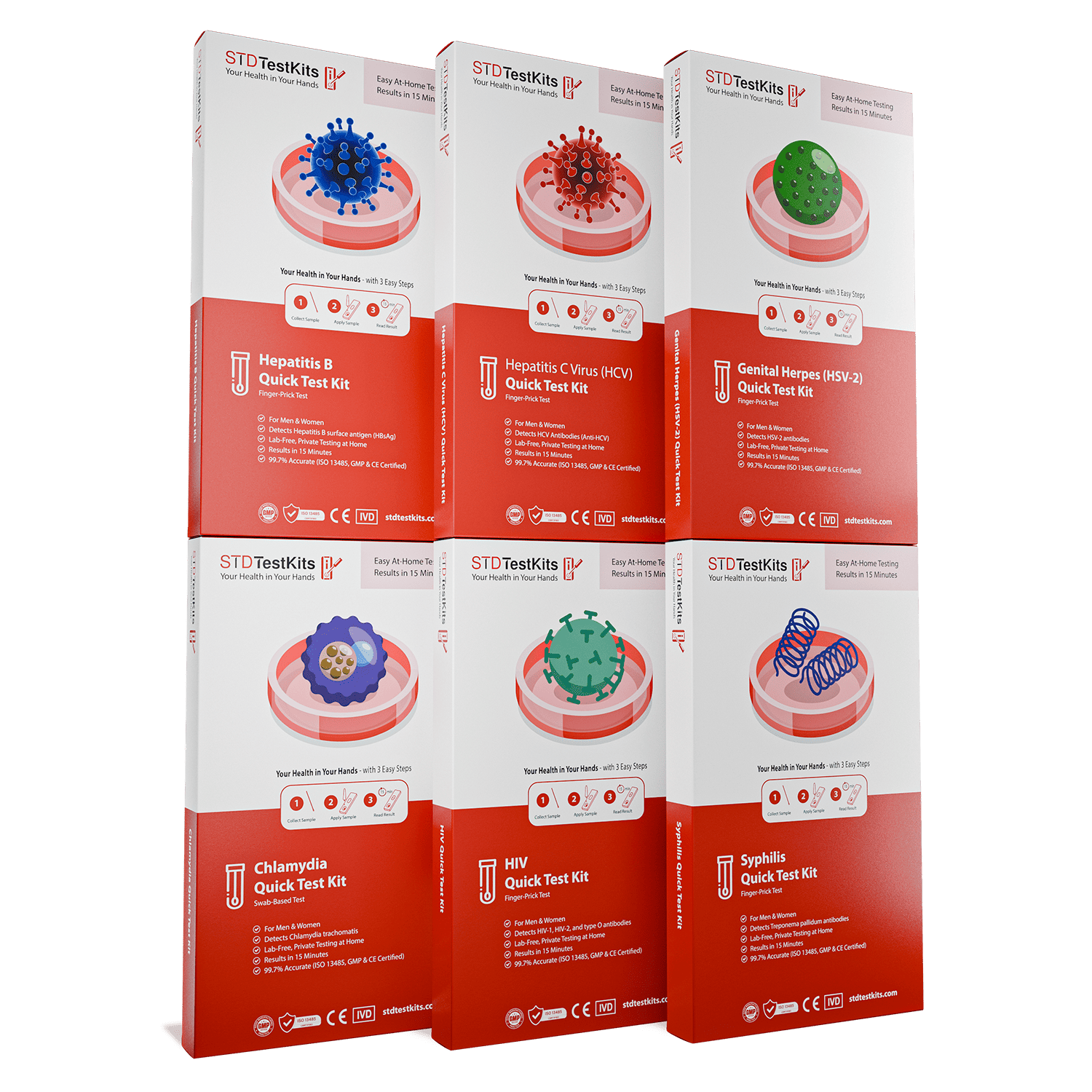STD Risk Checker Quiz: Do You Need to Get Tested?
Quick Answer: Yes, you can still get an STD at a sex party even if you use protection. Condoms reduce, but do not eliminate, risk, especially for STDs transmitted through skin-to-skin contact, oral sex, or shared toys.
Where the Gaps Are: What Protection Doesn’t Always Cover
Condoms are powerful tools, but they’re not a forcefield. Most people think of protection as an on/off switch. Used a condom? Safe. Didn’t? Unsafe. But the reality is messier. Protection isn’t just about penetration; it’s about what kinds of contact happened, what fluids were exchanged, and what kinds of STDs are most easily spread skin-to-skin, not just fluid-to-fluid.
Let’s talk about Herpes, HPV, and Syphilis, three infections that can spread through areas not covered by a condom. That includes thighs, pubic area, and even fingers if there are open cuts or lesions. Add in kissing, oral sex, and shared toys or gear, and you start to see the cracks in the “protected” assumption. According to CDC estimates, more than half of adults have oral herpes, and many don’t even know it. So one kiss or unprotected oral exchange at a party could be all it takes.
Many well-run sex-positive events go to great lengths to reduce transmission risk: gloves at every station, toy cleaning protocols, on-site testing referrals. But they can’t control biology. Even well-informed, highly consent-based gatherings carry risk because not every STD is stopped by a barrier method.
What Makes Sex Parties Different (and Sometimes Safer)
This may surprise you: studies suggest that people who attend organized sex parties may actually engage in safer practices than the average hookup from an app. Why? Because many sex-positive events are curated spaces with agreed-upon norms, informed consent education, and on-site safety resources. That’s not always the case at a random Friday night bar hookup. In fact, research from community-led groups shows higher condom usage rates and more frequent STI testing among regular attendees of group sex events compared to the general population.
But that doesn’t erase the physical realities of group sex environments. Even in cleaner, more protocol-driven spaces, there’s a mix of bodies, fluids, toys, and surfaces. You might be careful, but you’re relying on others to be, too. It’s not about shame, it’s about physics and exposure. If someone has an active case of Trichomoniasis and uses a toy that’s then shared without a wipe-down, that risk can transfer. And not every STD shows symptoms immediately, or at all. Many people at these events feel totally healthy while unknowingly contagious.
One anonymous Reddit poster described their first experience at a queer dungeon party: “There were gloves, condoms, wipes everywhere, and everyone was great about asking consent. But I still went for testing the next week because we used the same lube bottle, and I couldn’t stop wondering if that could be a thing.” It could. That’s not paranoia, it’s smart harm reduction.
Figure 1. Even when condoms are used, certain activities carry residual STD risk due to skin contact, fluid presence, or incomplete barrier coverage.

People are also reading: Trichomoniasis vs Prostatitis: What’s Really Causing Your Symptoms?
Why “I Feel Fine” Doesn’t Mean You’re in the Clear
Two weeks after the party, Amanda still had no symptoms. No burning, no discharge, no sores. Just the lingering memory of kissing three different people and sharing a wand vibrator with someone who’d been popular that night. She almost didn’t test. After all, she’d felt fine. But when she got a message in the group chat that someone from that night had tested positive for chlamydia, her stomach dropped.
This is the quiet trap of STDs. Many don’t show symptoms for days, weeks, or ever. According to CDC data, about 70% of women and 50% of men with chlamydia report no noticeable signs. With gonorrhea, it’s similar. Herpes? You might not see sores until your second or third outbreak. And some infections, like HPV, can silently linger for years without detection unless specifically tested for.
So when people say, “I’m good, I feel fine,” they’re often relying on absence of symptoms instead of actual testing. In group sex settings, that mindset can be dangerous, not because anyone is malicious, but because so many STDs are sneaky. You might be incubating an infection long before your body sends a signal.
When to Test After a Sex Party (Timing Matters More Than You Think)
Imagine this: you go to a sex party on a Saturday. You test Monday because you’re anxious. The results come back negative. You breathe easy. But then two weeks later, you develop a sore throat and notice a strange discharge. What happened?
The test was too early. That “window period” is the time between exposure and when a test can reliably detect the infection. Testing too soon can create a false sense of reassurance. Each STD has a different window period, which is why one-size-fits-all timelines don’t work. Here’s what the actual science says:
Figure 2. Estimated testing timelines by infection. Always confirm with your provider or test kit instructions.
If you're feeling unsure after an event, here’s a better strategy than testing too early and risking a false negative: wait at least one week for common bacterial infections, and consider a retest at the three-week or six-week mark depending on symptoms and exposures. Some people also do an early baseline test for peace of mind, then follow up with a second test after the window has closed.
If you’re someone who attends parties regularly or has multiple partners in a month, setting a standing testing rhythm, like every 30 or 60 days, can be one of the smartest ways to manage your sexual health without waiting for symptoms or scares.
Peace of mind isn’t just about what you feel, it’s about what you know. If you're in that limbo space, wondering whether a rash or a sore throat could be something more, clarity is one test away. Our combo STD home test kit is a discreet, lab-grade option that covers multiple infections and gets you answers fast.
Protocols, Not Perfection: How Safer Sex Actually Works at Events
Many sex party organizers take community safety seriously. It's not uncommon to find hosts distributing dental dams, gloves, lube, and condoms in every playroom. Some events go further, requiring proof of recent STD testing or offering rapid HIV testing at check-in. One volunteer at a well-known Los Angeles play party shared, “We sanitize every toy station between rounds, have multiple glove sizes, and post signage about rimming and oral risks. It’s about shared responsibility, not fear.”
But even with all that structure, things happen. Barriers can break. Someone might forget to change gloves between partners. You might use the same lube bottle as someone else, and if it’s been double-dipped or contaminated, that counts as a potential exposure. The vibe might feel clean and respectful, but the microscopic world doesn’t care about vibes.
That doesn’t mean you should panic. It means you should plan. Testing after an event isn’t an accusation, it’s a routine part of being sexually active, just like brushing your teeth after a night out. The real harm comes when people internalize testing as shameful. If you can reframe testing as part of caring, for yourself and the people you share intimacy with, it stops being a stressor and becomes a form of integrity.
What If You Test Positive After a Sex Party?
Let’s say you do everything right. You wait the proper amount of time. You test. And it comes back positive. That’s a gut punch, but it’s not a moral failure. Most STDs are easily treatable. The bigger hurdle for many people isn’t medication, it’s shame.
Take Jamie, 31, who tested positive for gonorrhea two weeks after their first group sex experience. “I was mortified,” they said. “Not because I was sick, but because I didn’t want anyone to think I was careless. But once I told the person I’d shared a toy with, they thanked me for being honest and said they’d get tested too. No drama. Just grown-up stuff.”
Partner notification doesn’t have to mean confrontation. It can mean a simple text, a note in a group chat, or even using anonymous partner notification tools. And if you're not sure whether the test was accurate, or if you’re still in the window period, most providers recommend a confirmatory test or retest in a few weeks.
If you're feeling overwhelmed, remember this: STD Rapid Test Kits offers multiple discreet options for retesting or confirming results. You’re never stuck. You’re not alone. And every step you take is a step toward clarity and care, not confession or punishment.

People are also reading: Can Heat Rash Be an STD? Here’s When to Worry
Rimming, Skin Contact, and All the Other Things We Don’t Talk About
There’s something especially taboo about the risks that live outside the condom narrative. Rimming? Mutual masturbation? Toys in multiple bodies? These are common, pleasurable, and often under-discussed. But they still come with risks, especially when skin or mucous membranes are involved.
Herpes and HPV are notorious for spreading through these types of contact. Rimming can expose you to Hepatitis A, parasites, and oral or rectal gonorrhea. Even shared towels or sex furniture, if not properly cleaned, can occasionally harbor bacteria or viruses. Is it common? No. Is it possible? Yes.
This isn’t about policing behavior. It’s about full-spectrum awareness. When people only associate STDs with unprotected vaginal or anal sex, they miss out on the real picture. The truth is, most STDs don’t need full-on penetration to spread. They need opportunity. Friction. Moisture. Skin contact. That’s it.
That’s why testing, not guessing, is the cornerstone of safer sex, especially in high-contact environments like sex parties. You might have used every barrier method available and still left with questions. That’s normal. That’s human. That’s why we have tools to test and retest as needed.
“I Used Protection… So Why Am I Still Anxious?”
For some people, the scariest part of a sex party isn’t what happened, it’s what might happen after. You could’ve done everything right: used protection, cleaned toys, skipped anything that felt sketchy. And yet here you are, Googling symptoms you don’t have and trying to remember if that one person coughed near you or not.
That’s not irrational. That’s what bodies do with uncertainty. When you mix pleasure with vulnerability, especially in spaces that challenge what society deems “normal”, your nervous system can light up like a threat detector. One small bump on your thigh, a weird smell, a dry throat, and suddenly you're spiraling. Did I mess up? Should I have said no to oral? What if I missed a spot shaving and now I have syphilis?
Here’s the truth: being anxious after group sex isn’t a sign you did something wrong. It’s a sign you care about your health, and possibly your partners’ too. But that care can get hijacked by shame and stigma if you don’t interrupt the cycle. That’s where testing comes in. Testing doesn't just check for infections, it checks your fear against reality. And often, reality is more manageable than the spiral in your head.
We’ve seen people lose sleep over phantom symptoms. We’ve also seen people catch real infections early, treat them fast, and move on without drama. Both stories start in the same place: uncertainty. But the ones that end in empowerment all have one thing in common, they chose knowledge over avoidance.
If you're sitting with that pit in your stomach, wondering if you should wait, test, or just forget it happened, here's your nudge: test. Not because you're dirty. Not because you were risky. But because you deserve to stop guessing and start breathing easier. Whether it’s a $20 rapid test or a full combo kit, the result is more than a diagnosis, it’s a reset button on your peace of mind.
And if you're reading this and thinking, “Well, I guess this is just who I am now. An anxious STD Googler at 3AM,” let us be the first to say: same. Welcome. You’re doing just fine. Now let’s get you some clarity.
FAQs
1. Can I still get an STD if I always used condoms?
Yes, because condoms only protect some parts of the body. You can get herpes, HPV, and syphilis from skin that isn't protected, like the base of the penis, the inner thighs, or even kissing. You were smart to use protection, but there’s still a little room for things to sneak through.
2. I feel totally fine. Do I still need to test?
That’s the sneaky thing about most STDs, they don’t always show signs. You could have chlamydia or gonorrhea and not feel a thing for weeks (or ever). Testing when you feel fine isn’t overreacting, it’s how a lot of people catch things early, treat them fast, and protect their future hookups too.
3. Is it true I can get something from sharing a toy or lube bottle?
Yep, especially if it wasn’t cleaned between uses or if fingers go from one person to another without a glove swap. Same goes for double-dipping into lube or reusing condoms on different partners. It’s not about paranoia, it’s just how fluid transfer works. No shame, just science.
4. How soon after a party should I test?
Depends what you're testing for. Most bacterial infections like chlamydia or gonorrhea show up within 7–14 days. HIV and syphilis might take 3–6 weeks to show on a test. If you’re anxious, start with a baseline test and plan for a retest a few weeks out for full accuracy.
5. What if I got tested a few days after the party and it was negative?
It was a good start, but maybe it was too soon. That first test is like a picture: it helps, but it's not the whole movie. Some people test again after 3–6 weeks just to be sure, especially for infections with longer windows like syphilis or HIV. You’re not being extra, you’re being thorough.
6. Can I get herpes from oral or kissing?
Absolutely. Oral herpes (HSV-1) spreads through mouth-to-mouth and mouth-to-genital contact. You don’t need penetration, symptoms, or even visible sores to pass it. That’s why a quick hookup kiss can sometimes come with a surprise later. It’s more common than you think, and very manageable.
7. What do I say if I test positive and don’t know who to tell?
Start with compassion, for yourself first. You didn’t do anything wrong. If you can reach out to partners, a simple message like “Hey, just a heads up, I tested positive for [X]. You might want to get checked too” is enough. If you can’t or don’t want to, anonymous partner services exist too. You’ve got options.
8. Is group sex riskier than regular one-on-one hookups?
Not necessarily. The number of people doesn’t automatically mean more risk, it’s about what kinds of contact happen, how much fluid is shared, and whether testing is part of the mix. In fact, some sex party communities are way more testing-aware than your average dating app.
9. I used a condom but now I’m paranoid, am I just spiraling?
You’re not alone. This happens to a lot of people. Anxiety loves to fill in the blanks, especially after something new, exciting, or outside your usual comfort zone. Testing gives you actual data to work with. Whether it’s peace of mind or a treatment plan, knowing is way better than guessing.
10. Should I test again if I go to events regularly?
Yes, and ideally on a rhythm that fits your life. Monthly? Every six weeks? After every new partner? That’s your call. But routine testing isn’t overkill. It’s care. Think of it like dental cleanings but for your sexual health, especially if you play in high-contact or high-trust spaces.
You Deserve Answers, Not Assumptions
Sex parties don’t have to mean danger, and condoms don’t guarantee immunity. The truth lives somewhere in between: STDs can still spread in protected, well-managed, sex-positive spaces. But the risk isn’t unmanageable. You can keep exploring without fear driving your decisions if you test smartly, set clear times, and don't feel ashamed.
Don’t wait and wonder, get the clarity you deserve. This home test kit checks for the most common STDs quickly and without drawing attention to itself.
How We Sourced This Article: We combined current guidance from leading medical organizations with peer-reviewed research and lived-experience reporting to make this guide practical, compassionate, and accurate.
Sources
1. Condom use and STD prevention (CDC)
2. About STI risk and oral sex (CDC)
3. Sexually transmitted infections (WHO)
4. Kissing, fellatio, and analingus as risk factors for oropharyngeal gonorrhoea
5. High prevalence of rectal chlamydia and gonorrhea among men who have sex with men
6. Chlamydia trachomatis transmission
7. Pharyngeal gonorrhea transmission via kissing, rimming, and saliva
About the Author
Dr. F. David, MD is a board-certified infectious disease specialist focused on STI prevention, diagnosis, and treatment. He blends clinical precision with a no-nonsense, sex-positive approach and is committed to expanding access for readers in both urban and off-grid settings.
Reviewed by: Janelle M., RN, MPH | Last medically reviewed: November 2025
This article is meant to give you information, not to give you medical advice.







